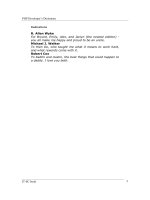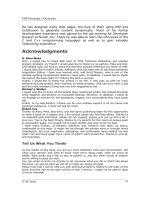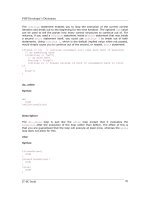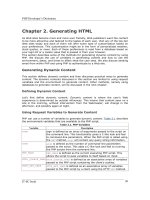PHP Developer''''s Dictionary- P4 docx
Bạn đang xem bản rút gọn của tài liệu. Xem và tải ngay bản đầy đủ của tài liệu tại đây (379.08 KB, 5 trang )
PHP Developer’s Dictionary
IT-SC book
70
The
continue
statement enables you to stop the execution of the current control
iteration and break out to the beginning for the next iteration. The optional num value
can be used to tell the parser how many control structures to continue out of. For
instance, if you used a continue statement inside a while statement that was inside
a second while statement itself, you could use continue 2 to break out of both
statements. Using
continue 1
, which is the default implied value when not passed,
would simply cause you to continue out of the second, or nested,
while
statement.
if($num == 5){ // continue statement will come back here if executed
// do something here
if($string == "go"){
// do more here
$string = "stop";
continue 2; // breaks outside of both if statements back to first
if
}
$num++;
}
do while
Syntax
do{
code
}while(condition)
Description
The
do while
loop is just like the
while
loop except that it evaluates the
condition
after the execution of the loop rather than before. The effect of this is
that you are guaranteed that the loop will execute at least once, whereas the
while
loop does not allow for this.
else
Syntax
if(condition){
code
[
}elseif(condition){
code
]
}else{
code
}
PHP Developer’s Dictionary
IT-SC book
71
Description
The
else
statement, which extends the
if
or
elseif
statements, provides a default
set of code to be executed if previous if or elseif statements fail condition . The
brackets around the
elseif
portion of the syntax example show that this is an
optional part of a statement, whereas the if portion is required for the else
statement.
elseif
Syntax
if(condition){
code
}elseif(condition){
code
[
}else{
code
]
}
Description
The
elseif
statement, which extends the
if
statement, provides a second
evaluation on a second condition
before a set of code
is to be executed. This
assumes that previous
if
or other
elseif
statements fail their respective condition
. The brackets around the
else
portion of the syntax example show that this is an
optional part of a statement, whereas the
if
portion is required for the
elseif
statement.
for
Syntax
for([assignment];[condition];[change_assignment]{
code
}
Description
The
for
loop has been labeled as the most complex looping structure not only in
PHP, but in other programming languages as well. This loop takes an initial
PHP Developer’s Dictionary
IT-SC book
72
assignment
where a variable is assigned a value. The second parameter specifies a
condition that is evaluated before each iteration of the loop. If the condition
evaluates to true, the code is executed and the change_assignment , such as
increasing or decreasing the assignment by 1, is performed. At that time, the
condition is reevaluated with the new value of the assignment and the process
repeats itself. This continues until condition is false.
These parameters are all optional, which might come as a surprise. Leaving them, or
even just
condition
, blank will cause the
for
to loop indefinitely, but does allow
you to use an internal break statement to end the loop. You can also see the
for : endfor
entry for a different syntactical way to use the
for
loop.
Note
If you want to get extra tricky with the for loop, you can also include
comma-separated code to be executed in the change_assignement . For
instance, you could use
print $counter, $counter++
to print the
$counter
value on each iteration through the loop. For more information
about what the ++ means in this example, see the "Incrementing and
Decrementing" section later in this chapter.
for : endfor
Syntax
for([assignment];[condition];[change_assignment]):
code
endfor
Description
The
for : endfor
loop is an alternative syntax for the
for
loop. Using this
method, the opening and closing braces are replaced with
:
and
endfor
,
respectively. See the
for
entry for more information on condition
and code
.
foreach
Syntax
foreach(array as current_value){
code
}
foreach(array as current_key => current_value){
code
PHP Developer’s Dictionary
IT-SC book
73
}
Description
The foreach loop, which was added in PHP4, has two syntactical definitions. In both
definitions the loop takes an array and iterates through it. In doing so, it stores the
current_value so that it can be referenced and processed in code . For associative
arrays, you can use the second syntactical definition to also store the corresponding
current_key
for processing in code. The following example should help clarify:
// create an array
$weekdays = array (
"Sunday" => 0,
"Monday" => 1,
"Tuesday" => 2,
"Wednesday" => 3,
"Thursday" => 4,
"Friday" => 5,
"Saturday" => 6
);
// print out each day with the number it is associated with
foreach($weekday as $day => $number) {
print "\ $weekday = $day.\ n";
}
if
Syntax
if(condition){
code
}
[
elseif(
condition
){
code
}else{
code
}
]
Description
The
if
statement enables you to execute code
based on successful validation of
condition
. This statement is one of the most widely used statements in any
programming language, and PHP is no different. Optionally, as the syntax description
PHP Developer’s Dictionary
IT-SC book
74
shows, it is often used in conjunction with
elseif
and/or
else
statements to provide
addition levels of control over code execution.
if : endif
Syntax
if(condition):
code
endif;
Description
The if : endif statement is an alternative syntax for the if statement. Using
this method, the opening and closing braces are replaced with
:
and
endif
,
respectively. See the entry for
if
for more information on condition and code .
include()
Syntax
include(string filename)
Description
The
include()
function enables you to include other files specified by
filename
.
These secondary files can be valid PHP code or any text, such as HTML. If you do
have additional PHP code that needs to be executed, be sure that you use the proper
beginning and ending PHP tags or the parser will not execute the code.
The
require()
language construct has similar capabilities. The major difference is
that
include()
is executed each time it is encountered, whereas
require()
pulls in
the contents of the included file once. You can see the difference if you place these
functions in the body of a loop statement.
Tip
You can place a
return
statement in the included file to terminate the
parsing of the file and return to the file that performed the inclusion.
require()
Syntax









